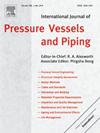使用优化特征子集选择的机器学习模型预测铬钼压力容器钢的蠕变寿命
IF 3.5
2区 工程技术
Q2 ENGINEERING, MECHANICAL
International Journal of Pressure Vessels and Piping
Pub Date : 2024-10-28
DOI:10.1016/j.ijpvp.2024.105349
引用次数: 0
摘要
数据驱动的蠕变寿命预测方法通常将材料成分、制造细节和使用条件等众多特征整合到机器学习模型中。本研究针对 2.25Cr1Mo 压力容器钢建立了基于机器学习的蠕变寿命预测方法,并对特征子集进行了优化选择。在模型训练和测试之前,选择了对 2.25Cr1Mo 钢蠕变寿命有重大影响的六个关键特征,特别是应用应力、温度以及由 Cr、Ni、Mn 和 Mo 组成的化学成分。利用各种机器学习算法和传统的 L-M 方法进行模型训练和性能评估。此外,还使用独立于训练和测试数据集的实验数据对所开发的模型进行验证,以评估其泛化能力。结果表明,在所有测试模型中,支持向量回归(SVR)模型与最佳特征子集相结合,显示出更高的预测精度和泛化能力。最后,利用 Python 编程语言将表现出最佳性能的蠕变寿命预测模型部署到软件应用程序中。该预测工具仅依靠有限的输入信息,就能对 2.25Cr1Mo 压力容器钢进行快速、精确的蠕变寿命预测,并能清晰、直观地展示预测结果。本文章由计算机程序翻译,如有差异,请以英文原文为准。
Predicting creep life of CrMo pressure vessel steel using machine learning models with optimal feature subset selection
The data-driven approach for creep life prediction typically integrates numerous characteristics, including material compositions, manufacturing details, and service conditions, into machine learning models. In this study, a machine learning-based creep life prediction approach with optimal feature subset selection is established for 2.25Cr1Mo pressure vessel steel. Before model training and testing, six critical features that significantly impact the creep life of 2.25Cr1Mo steel are selected, specifically the applied stress, temperature, and chemical compositions consisting of Cr, Ni, Mn, and Mo. Various machine learning algorithms, along with the traditional L–M method, are utilized for model training and performance evaluation. Additionally, the developed models undergo validation using experimental data independent of the training and testing datasets to assess their generalization abilities. The results reveal that, among all tested models, the support vector regression (SVR) model, coupled with the optimal feature subset, demonstrates superior prediction accuracy and generalization capability. Finally, the creep life prediction model exhibiting optimal performance is deployed into a software application, leveraging the Python programming language. This predictor tool facilitates rapid and precise creep life predictions for 2.25Cr1Mo pressure vessel steel, relying solely on a limited amount of input information, and provides a clear and visual presentation of the prediction results.
求助全文
通过发布文献求助,成功后即可免费获取论文全文。
去求助
来源期刊
CiteScore
5.30
自引率
13.30%
发文量
208
审稿时长
17 months
期刊介绍:
Pressure vessel engineering technology is of importance in many branches of industry. This journal publishes the latest research results and related information on all its associated aspects, with particular emphasis on the structural integrity assessment, maintenance and life extension of pressurised process engineering plants.
The anticipated coverage of the International Journal of Pressure Vessels and Piping ranges from simple mass-produced pressure vessels to large custom-built vessels and tanks. Pressure vessels technology is a developing field, and contributions on the following topics will therefore be welcome:
• Pressure vessel engineering
• Structural integrity assessment
• Design methods
• Codes and standards
• Fabrication and welding
• Materials properties requirements
• Inspection and quality management
• Maintenance and life extension
• Ageing and environmental effects
• Life management
Of particular importance are papers covering aspects of significant practical application which could lead to major improvements in economy, reliability and useful life. While most accepted papers represent the results of original applied research, critical reviews of topical interest by world-leading experts will also appear from time to time.
International Journal of Pressure Vessels and Piping is indispensable reading for engineering professionals involved in the energy, petrochemicals, process plant, transport, aerospace and related industries; for manufacturers of pressure vessels and ancillary equipment; and for academics pursuing research in these areas.

 求助内容:
求助内容: 应助结果提醒方式:
应助结果提醒方式:


